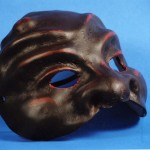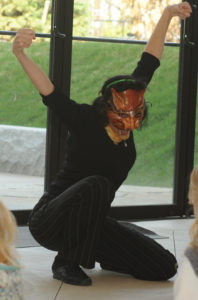This week’s blog is Part Two of Mask-Making Tips, with a focus on Aquaplast. For tips specific to making masks with paper mache (or papier maché), read my earlier blog, Mask-Making Part One and check out Mask-Making Part Three for how to make a mask with a manila folder.
Aquaplast: What is it?
 Aquaplast is a medical plastic that becomes pliable when immersed in boiling (or near-boiling) water. It comes in different types, each of which has different shaping/molding properties. It’s made by Sammons Preston Rolyan, and can be purchased online from any large medical company (like Patterson Medical or Sears or MedexSupply).
Aquaplast is a medical plastic that becomes pliable when immersed in boiling (or near-boiling) water. It comes in different types, each of which has different shaping/molding properties. It’s made by Sammons Preston Rolyan, and can be purchased online from any large medical company (like Patterson Medical or Sears or MedexSupply).
What are the pros and cons of using it?
Pros
There are two biggies (and a couple of “smallies”). One, it is an ideal material if you are looking to build a permanent collection. The plastic is durable and hardy, can sustain being dropped or even sat upon by accident, and if properly cared for, can be beautiful and useful for decades. Performers love masks with ‘personal’ histories! Two, these plastics can be cleaned. That means that people can safely share a mask, which is critical for schools and universities. Small advantages are 1) heating and molding the plastic goes very very quickly. It cools in less than a minute! If you have 2 or 3 heated water stations, an entire class can complete the ‘work in plastic’ stage in 40 minutes; 2) with a couple of the types of Aquaplast, you can toss the plastic back into the water if you messed it up and have another go at it; 3) given samples/scraps to experiment with in advance, students can create extraordinary things, as the material itself is a joy to work with.
Cons
You need to be able to heat water safely, preferably in a lasagna pan 2) It’s expensive, at least the up-front cost is. Over time, of course, you save money by not having to replace them.
Here’s how to make your mask with aquaplast
Stage One: Sculpting the form
Getting Ready
The easiest sculpting material is traditional clay. Sculpy cannot withstand the heat of the boiled plastic. If you use traditional clay, get the stuff that the pottery class has to throw away. You’ll need less of your sculpting material if you make a ‘base’ of newspaper and masking tape, a small bowl, or a half a styrofoam head (the kind used to display hats and wigs). If you don’t use a mannequin, you will need to remind your students to hold their face up to the mold to mark where the eyes, nose, and edges of the head need to be.
Sculpting
Here’s the first tricky bit. If you are using the more resilient types (like the subset Aquaplast or Resilient T), they will smooth out your model, so you need to sculpt lager, clearly defined features. If you are using ProDrape or any of the Polymer subtypes, they will pick up every bump and wrinkle. The challenge is to make your mold as smooth as possible, with all the features very intentional and not too cluttered, although they can be small. The Aquaplast type that is the most “in the middle” is the type also called Aquaplast. IMPORTANT: Make your eyes either sockets or big and bulgy— you will be removing them and want it to be easy to do later.
Stage Two: Laying on the plastic
Heat water in the electric tea kettle that you borrowed from the English Department’s office. Take a metal lasagna pan, and put it on your heat source. Fill about 2/3 full with your boiling teakettle water. Bring the first few sculpted forms and put on the table close to the lasagna pan (doesn’t have to be the same table as the water, just close by). Make sure each student has two partners—some of this plastic hardens in 10-20 seconds, and you need more than one set of hands!
Put the plastic in the water with a teeny corner peaking out. The plastic will take imprints (the polymer will even show a fingerprint) but your hands are least likely to damage the plastic, so that corner is your ‘grab tab’. Don’t worry: The plastic doesn’t really get hot, oddly enough!
When the Aquaplast is clear (for the polymer, it doesn’t ever quite get there, but it will lighten), pull it out, shake off the water very quickly, then stretch a bit and lay over the sculpted form. As quickly and as smoothly as possible, press the plastic onto the form. Be careful not to get fingernail marks in the plastic. You will need to pinch up to define ridges, press down and into crevices, and continually use a wiping motion to keep it smooth. For the more resilient forms, you will be able to actually mold the plastic, because it takes a little longer to cool (maybe 25 seconds) BUT you will also be fighting it to be sure it holds the form!
Stage Three: Finishing up
There are three things left to do before you can paint, all of which can go fairly quickly. They are edges, eyes and strap holes.
Edges
Pull the mask from the sculpted form, take to a sink and wash off the clay in cold water. Then bring it back to your lasagna pan, which you have had to replenish with hot water. Look at the mask and sketch the outline of the edges in pencil. Then choose a place to begin, and dip that part into the water to heat to almost transparent (do not heat fully). Use scissors to cut away the excess. Continue all the way around the mask. Then, go back to smooth out these rough edges by dipping them just barely into the heated water till just those edges are transparent. Smooth and round them with your fingers.
Eyes
This is the most challenging, but also the most exciting—slightly changing the shape of the socket profoundly alters the masks’s expression!
Get a dipping cup (like a pyrex measuring cup) or your trusty tea kettle. Using your teakettle at a separate “station” is best, so you can avoid congestion. Holding the mask over a sink, basin, or other hot water receptacle, pour a small amount into the eyesocket. Let it sit, then pour it out. Repeat 2 or 3 times, then apologize to the mask and poke a slit (horizontal) with a scissor into the eyesocket, now (hopefully) somewhat pliable. Carefully clip up and down about 1/8-1/5 of an inch. Pour more water in and through to make the hole larger. Pour more water through, being sure to wedge in your finger so it doesn’t reseal! Heat the socket enough that you can create a good eyehole (make it larger than you think you need) using your fingers to mold the shape and roll/smooth the edges. Slightly pull out the bottom edge so it doesn’t poke you when you wear it; you can create a real ‘lid’ look which has the advantage of also being very comfortable!
Strap Holes
This is easy. Get a pencil and scissors. Open scissors and put one tip/blade into the boiling water for a moment or two. Then, grasp your mask and pick a spot near wear the temple might be, and apply the hot scissor vigorously, swivel it to create a hole. You will have to reheat your scissor once or twice. I usually do it so the scissor pokes through between two spread fingers that are supporting/pushing back from the inside. Now pour a bit of water through the hole and immediately poke your pencil through and leave it there while the hole cools. On the inside of your mask, squish the edges of the hole back down the pencil and flatten/smooth against the inside of the mask so they don’t poke you when you wear it. If they are already hard, dribble a little more hot water on them with the pencil still in place.
Repeat on the other side! You are now ready to paint—acrylics are best. On more quick tip: cut a separate piece of elastic for each side of the mask to tie behind your head to keep it in place on your face. Trying to perfectly size one piece is crazy-making!






